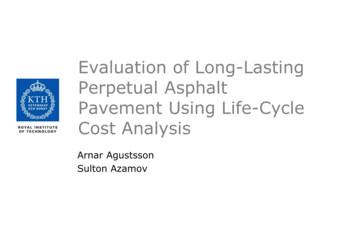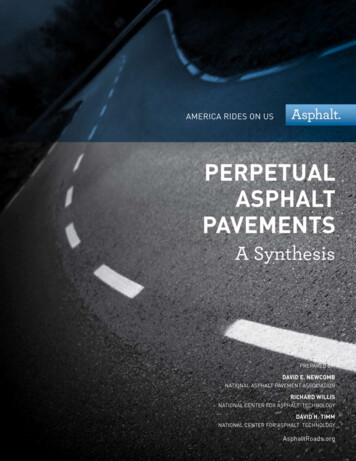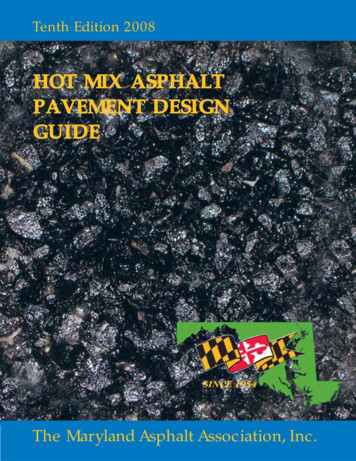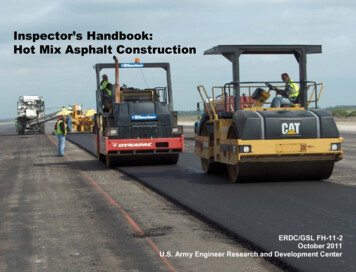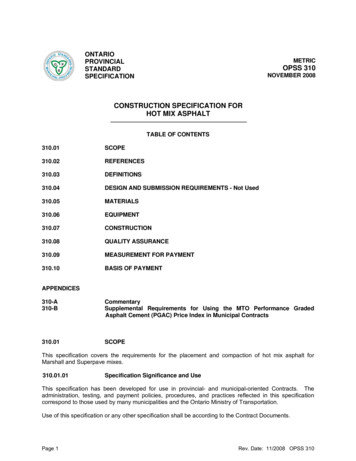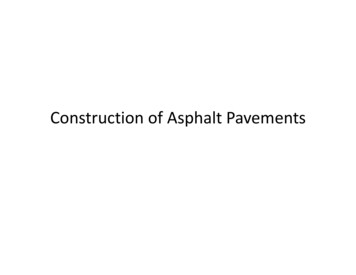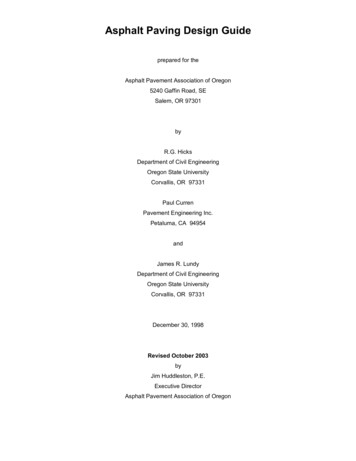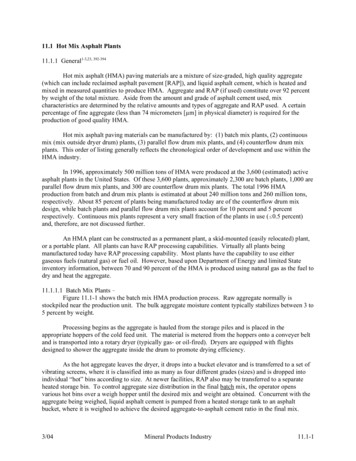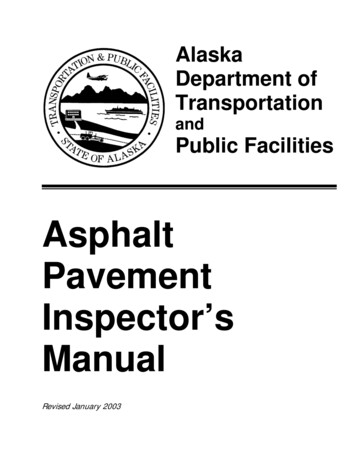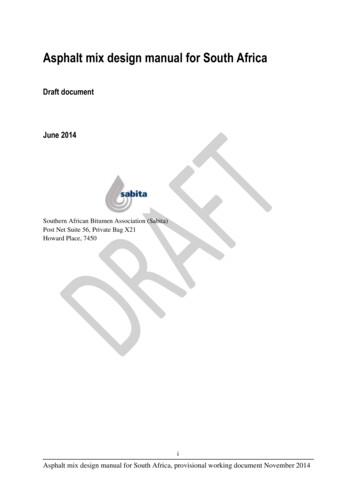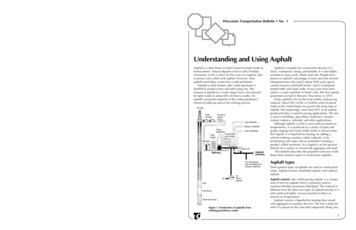
Transcription
Quality control and assurance are usually done bymeasuring mix density, asphalt content, air voids, andstability. Density and asphalt content are measured usingnuclear gauges or by extracting samples from the finishedpavement and using standard laboratory procedures.Surface treatments Specifications for surface treatmentsshould determine the type and grade of asphalt and thegradation and type of aggregate. The range of asphalt andaggregate application rates should be specified, but actualrates should be adjusted for field conditions; the asphaltgrade and application rate is correct if: It is fluid enough when applied to spray properlyand cover the surface uniformly, yet thick enough toremain in a uniform layer and not puddle indepressions or run off the pavement crown. It retains the proper consistency after application towet the applied aggregate. It cures and develops adhesion quickly. It holds the aggregate tightly enough to the roadsurface after rolling and curing that it will not bedislodged by traffic. When applied in the right amount it does not bleedor strip with changing weather conditions.Standard specifications Determine your specific jobrequirements. Consult the Wisconsin DOT manualStandard Specifications for Road and Bridge Constructionwhen ordering materials, setting specifications, anddetermining construction procedures. This usefulreference manual covers all aspects of road construction.Inspection For good quality assurance you must inspectthe construction process. Take samples of all materials totest for their compliance with your project specifications.Proper design specifications and inspection will pay forthemselves through good quality construction.Asphalt pavement recyclingAlthough timely maintenance can extend a pavement’susefulness, eventually its material will become old andneed replacement. Old asphalt pavement materials donot have to be wasted. They can be recycled as part ofthe reconstruction process.Old pavement material is called Reclaimed AsphaltPavement (RAP). RAP is combined, as necessary, withnew asphalt and/or recycling agents, and/or new aggregates to produce hot mix paving mixtures. This hot mixrecycling process is widely used in Wisconsin.Recycling is popular because it saves significantlyboth on costs and on natural resources, such as aggregates and asphalts. It also can improve pavementswithout changing their thickness, which is importantunder bridges and on streets with curb and gutter.When recycling is used, the RAP composition shouldbe determined, including aggregate gradation, asphaltcontent, and asphalt viscosity. New aggregates and newasphalts, or recycling agents, should be added to meet therequired new mixture design specifications. Recycledmixtures containing up to 50% RAP have shown performance in the field that is comparable to new mixtures.ReferencesWisconsin Transportation Bulletin No. 1Understanding and Using AsphaltAsphalt is a dark brown to black material mostly made ofhydrocarbons. Natural deposits exist in Lake Trinidad,Venezuela; in the La Brea Tar Pits near Los Angeles; andin porous rock called rock asphalt. However, mostasphalt used today comes from crude petroleum.Asphalt is what remains after crude petroleum isdistilled to produce fuels and lubricating oils. Theamount of asphalt in a crude ranges from a few percentfor light crudes to about 60% for heavy crudes. Anasphalt’s properties depend on the crude petroleum’schemical make-up and on the refining process.This list includes both the sources for this factsheet andother recommended publications on asphalts.Asphalt Institute publicationsAvailable from the Asphalt Institute, Research Park Dr.,PO Box 14052, Lexington, KY, 40512. All are in the ManualSeries unless noted.Asphalt Cold Mix Manual (MS-14), 3rd ed.The Asphalt Handbook (MS-4), 1989.Asphalt Hot-Mix Recycling (MS-20), 2nd ed.Asphalt in Pavement Maintenance (MS-16), 1993.A Basic Asphalt Emulsion Manual (MS-19), 2nd ed.Introduction to Asphalt (MS-5), 8th edition.Performance Graded Asphalt Binder Specification andTesting Superpave series No. 1 (SP-1), 1st edition.Specifications for Paving and Industrial AsphaltsSpecification series No. 2 (SS-2), 1987-88.Oil wellFieldstoragePumpingstationLight distillateMedium distillateTowerdistillationCondensersTubeand coolersheaterWisconsin Transportation Information CenterAvailable from the T.I.C., 432 North Lake St., Rm. 741,Madison, WI 53706, tel: 800/442-4615, fax: 608/263-3160.Heavy distillateStorageAsphalt PASER Manual, 1987Road Drainage, Wisconsin Transportation Bulletin No. 4Seal Coating and other Asphalt Surface Treatments,Wisconsin Transportation Bulletin No. 10ResidiumProcess unitORAsphaltcementsRefineryOther publicationsFor processinginto emusified andcutback asphaltsHot Mix Asphalt Materials, Mixture Design and Construction1991 edition, National Center for Asphalt Technology,211 Ramsay Hall, Auburn, AL, 36849-5354Hot-Mix Asphalt Paving Handbook US Army Corps ofEngineers, Report No. UN-13(CEMP-ET) 1991AirStandard Specifications for Road and Bridge ConstructionWisconsin Department of Transportation, Office ofConstruction, Standards Development, Sales andDistribution, PO Box 7916, Madison, WI 53707-7916AirblownasphaltGasPetroleumMarch 1996. Copyright 1996, Wisconsin Transportation Information Center. By Hussain Bahaia. (Figures 2 and 3 are adapted from Hot Mix Asphalt. All other figuresare from The Asphalt Handbook. See references above.) Wisconsin Transportation Bulletin is a series of fact sheets providing information to local town, municipal andcounty officials on street and highway design, construction, maintenance and management. They are produced and distributed by the Wisconsin Transportation InformationCenter, a project of the University of Wisconsin-Madison Department of Engineering Professional Development, funded by the Federal Highway Administration, WisconsinDepartment of Transportation and UW-Extension. Copies are available free while supplies last from the Transportation Information Center, UW-Madison, Department ofEngineering Professional Development, 432 N. Lake Street, Madison, WI 53706. Phone: 800/442-4615; Fax: 608/263-3160; e-mail: Donald@Engr.Wisc.EduUW-Madison provides equal opportunities in employment and programming, including Title IX requirements.Still8Sand and waterFigure 1. Production of asphalts fromrefining petroleum crudesAsphalt is valuable for construction because it issticky, waterproof, strong, and durable. It is also highlyresistant to many acids, alkalis and salts. People haveknown of asphalt’s advantages at least since the ancientMesopotamians who used it about 5000 years ago tocement masonry and build streets, and to waterprooftemple baths and water tanks. It may even have beenused as a water repellent in Noah’s Ark. The first asphaltpavement was laid in Newark, New Jersey in 1870.Today asphalt is by far the most widely used pavingmaterial. About 96% of the 2.4 million miles of pavedroads in the United States are paved with some type ofasphalt. Not surprisingly, more than 85% of all asphaltproduced today is used for paving applications. The restis used in buildings, agriculture, hydraulics, erosioncontrol, industry, railroads, and other applications.Although asphalt is solid or semi-solid at normal airtemperatures, it is produced in a variety of types andgrades ranging from hard, brittle solids to almost waterthin liquids. It is liquefied by heating, by adding asolvent (making a product called cutback), or byemulsifying with water and an emulsifier (creating aproduct called emulsion). As a liquid it can be sprayeddirectly on a surface or mixed with aggregate and sand.This bulletin describes the properties and uses of thethree most common types of construction asphalts.Asphalt typesThree general types of asphalts are used in constructiontoday: asphalt cement, emulsified asphalt, and cutbackasphalt.Asphalt cement, also called paving asphalt, is a component of hot mix asphalt which is primarily used toconstruct flexible pavements (blacktop). This material isdifferent from the other two types of asphalt because it issemi-solid and highly viscous (resistant to flow) atnormal air temperatures.Asphalt cement is liquefied by heating then mixedwith aggregates to produce hot mix. The mix is kept hotuntil it is spread on the road and compacted. Being very1
sticky, asphalt cement adheres to the aggregate particlesand binds them together. After cooling to normal airtemperature, hot mix makes a very strong pavingmaterial which can sustain heavy traffic loads.Asphalt cements are produced in different grades thatvary in consistency or resistance to flow. To maintainacceptable consistency in pavements, softer grades areusually used in cold climates while harder grades areused in hot climates.Emulsified asphalt, or emulsion, is made from asphaltcement. It is tiny particles of asphalt cement mixed withwater and an emulsifying agent — usually a detergent.Emulsions were first developed in the early 1900s andbegan being widely used in 1920s for dust control.Emulsions are called liquid asphalts because, unlikeasphalt cements, they are liquid at normal air temperatures and therefore do not require heat to liquefy.To produce emulsions, hot asphalt cement and watercontaining the emulsifying agent are pumped at highpressure through a colloid mill. The emulsifying agentcoats the asphalt particles and puts an electric charge ontheir surfaces. This charge causes the asphalt droplets torepel one another so they don’t combine. These chargesare used to categorize emulsions as cationic (positivecharge) or anionic (negative charge).Charges are important because they affect thecompatibility of emulsion with mineral aggregates.An anionic emulsion should be used with limestoneaggregate that usually bears a positive surface charge.A cationic emulsion should be used with siliceousgravel and sandstone because these aggregates usuallybear a negative surface charge.Colloid millStatorPumpWater EmulsifierGRADE702508003000SolventSettlement test is used to detect the tendency of asphaltglobules in the emulsion to settle out and separate fromwater during storage for five days. The storage test canalso be used. This uses a similar set-up but is completedin 24 hours. These tests determine how often the emulsion must be mixed to ensure proper application.Sieve test complements the settlement test and determinesthe percent of asphalt cement present in the form ofpieces, strings, or relatively large globules.Classification test distinguishes between rapid-settingcationic emulsions and other types by their failure to coata sand-cement mixture.Demulsibility test indicates the relative rate at whichasphalt globules in a rapid-setting emulsion will breakwhen spread in a thin film on soil or aggregates.Cement mixing test is used for slow-setting grades ofemulsified asphalts.Coating ability and water resistance test determines theability of an asphalt emulsion to coat aggregates, towithstand mixing action, and to resist the washing actionof water after mixing. The results of this test tell us whichemulsions are suitable for mixing with coarse aggregates.Particle charge test is used to separate anionic fromcationic emulsions for rapid and medium setting grades.Asphalt cementApprox. furol vis., 140 F, SEC.,Approx. kinematic vis., 140 F, CSPressure gauge Clearance0.005-0.030 in.ThermometerStorage30PumpRotorStorageSaybolt Fural viscosity test measures the resistance ofemulsified asphalt to flow at 77 or 122 F (25 or 50 C).Cutback asphalt is another liquid asphalt that can beused at normal air temperatures without heating. Cutbacks are produced by adding (cutting back) petroleumsolvents to asphalt cements instead of water. Cutbackasphalts set when the solvent evaporates after beingapplied to the aggregate. The evaporation rate dependson the type and amount of solvent used in the cutback.Cutbacks have three grades based on relative evaporation rates. Rapid-curing (RC) is produced by adding ahigh volatility solvent such as gasoline or naphtha.Medium-curing (MC) is produced by adding an intermediate volatility solvent such as kerosene. Slow-curing(SC) is produced by adding an oil of low volatility suchas diesel or other gas oil.RC cutbacks set faster than MC which in turn set fasterthan SC. Cutbacks come in different grades that varysignificantly in their consistency. Specifications are givenin the following ASTM Standards: D2026 for SC, D2027for MC, and D2028 for RC.Naptha for RCKerosene for MCLight oil for SCHotasphalttankThe HF indicates high-float emulsion. This contains achemical that permits the asphalt emulsion to form athicker film on the aggregate with minimum drainage.Tests for emulsified asphalt properties measure viscosity,rate of setting, storage stability, particle charge, andability to coat aggregates.All emulsions are further graded according to theirsetting rate: rapid setting (RS), medium setting (MS), andslow setting (SS). The type and amount of emulsifyingagent controls the rate of setting.Select and use emulsions according to their settingrates. ASTM Standard D3628 recommends that RSemulsions be used for seal coats and penetration macadam pavements. The MS emulsions are recommendedfor open-graded cold asphalt-aggregate mixtures. SSemulsions are used for tack coats, slurry seals, anddense-graded cold asphalt-aggregate mixtures.StorageFigure 2. Manufacture of emulsified asphaltAfter an emulsion is mixed with aggregates it sets orbreaks. The asphalt droplets react with the aggregate andcoalesce or combine, squeezing out the water. The waterthen evaporates, leaving the asphalt droplets to set andproduce a continuous film on the 800 1500-3000800-1600 3000-6000Figure 3. Composition of cutback asphaltsCutbacks are increasingly being replaced by emulsions due to environmental regulations and otherconcerns. Emulsions release far fewer volatiles into theatmosphere an
The Asphalt Handbook (MS-4), 1989. Asphalt Hot-Mix Recycling (MS-20), 2nd ed. Asphalt in Pavement Maintenance (MS-16), 1993. A Basic Asphalt Emulsion Manual (MS-19), 2nd ed. Introduction to Asphalt (MS-5), 8th edition. Performance Graded Asphalt Binder Specification and Testing Superpave series No. 1 (SP-1), 1st edition. Specifications for Paving and Industrial Asphalts

